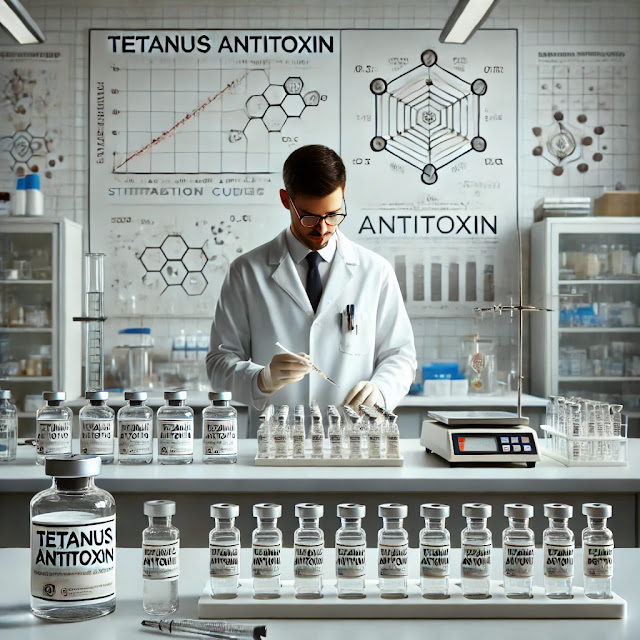The manufacturing and standardization of tetanus antitoxin is a detailed process that involves several stages aimed at ensuring the production of safe, effective, and standardized therapeutic agents for treating tetanus. Tetanus antitoxin is primarily used to neutralize the tetanus toxin (produced by Clostridium tetani) in humans. It is generally produced in animals, especially horses, as a form of passive immunization. Here's a breakdown of the key steps in the process:
1. Manufacturing Process:
Immunization of Animals:
- Large animals like horses are typically used because they can generate substantial amounts of antibodies.
- The animal is injected with an inactivated form of Clostridium tetani toxin (tetanus toxoid) in small doses.
- This injection is done repeatedly over time to stimulate the immune system of the horse to produce tetanus-specific antibodies.
Collection of Antiserum:
- Once the horse has built up a sufficient immune response, blood is collected from the animal.
- The plasma is separated from the blood cells because it contains the antibodies.
- These antibodies form the basis of the tetanus antitoxin.
Purification of Antibodies:
- The collected plasma undergoes various purification steps to isolate the antibodies (immunoglobulins) responsible for neutralizing tetanus toxin.
- This process includes filtration, precipitation, and sometimes enzymatic treatment to reduce non-specific proteins and enhance the purity of the product.
- To reduce the risk of serum sickness (a reaction to foreign proteins), the product may be further treated to fragment and reduce the size of the immunoglobulin molecules.
Formulation:
- The purified antitoxin is formulated into a stable product, which may include the addition of preservatives like phenol or formaldehyde to maintain its potency and shelf-life.
2. Standardization Process:
Potency Testing:
- The strength (potency) of the antitoxin must be standardized to ensure it provides effective protection against the tetanus toxin.
- The potency is measured in International Units (IU), which represents the quantity of antitoxin required to neutralize a specific amount of tetanus toxin.
- Animal models (such as mice) are used in potency assays, where known amounts of toxin and antitoxin are mixed, and the neutralizing activity is observed.
Safety Testing:
- Safety tests are conducted to ensure the antitoxin is free from contaminants and does not cause undue reactions in humans.
- Pyrogenicity tests (to check for fever-inducing contaminants) and sterility tests (to ensure there are no infectious agents) are performed.
Stability Testing:
- Stability tests are carried out to ensure that the antitoxin remains effective over its shelf life under various storage conditions.
Regulatory Compliance:
- Manufacturers must comply with international regulatory standards, such as those set by the World Health Organization (WHO) or national agencies like the U.S. FDA.
- Batch-to-batch consistency is critical, and each batch is tested for potency, purity, and safety before it can be distributed.
3. Distribution and Usage:
- Once the tetanus antitoxin is standardized and approved, it is packaged and distributed for medical use.
- It is administered either as a prophylactic measure (for example, after injury in people with an uncertain vaccination history) or therapeutically in cases of suspected tetanus infection.
Challenges and Considerations:
- Serum Sickness: A common complication from the use of animal-derived antitoxins is serum sickness, where the patient’s immune system reacts to the foreign animal proteins. Reducing the immunogenicity of these proteins is a key focus in the purification process.
- Human-Derived Alternatives: Advances are being made toward producing human-derived tetanus immunoglobulin, which has a lower risk of adverse reactions compared to horse-derived products.
the manufacturing and standardization of tetanus antitoxin require careful attention to animal immunization, antibody purification, and strict quality control measures to ensure that the final product is potent, safe, and effective.













0 Comments
Thanks for your feedback, ll get back to you soon